Members of the Royal Family have been Benchers at the Middle Temple since 1861, when Albert, Prince of Wales, later King Edward VII, was Called to the Bench. The Royal Bencher that arguably had the greatest influence on the Inn was Queen Elizabeth, the Queen Mother. Her election to the Bench in 1944 made her both the first woman and the first crowned king or queen to be made a Bencher. Her Majesty was charmed by the Society and became a lifelong visitor, attending Grand Days, Family Dinners and a myriad of other events. The Queen was known for her remarkable warmth and charm, and her fondness for the Middle Temple was returned in equal measure by the affection of its membership towards their Royal Bencher.
Queen Elizabeth’s association with the Middle Temple was made possible by the constitutional crisis provoked by Prince Edward, Duke of Windsor, who was elected a Royal Bencher of the Inn in 1919 when he was Prince of Wales. In 1936, after the death of King George V, Prince Edward became King Edward VIII and declared his intention to marry the American divorcee Wallis Simpson. Remarriage after divorce was frowned on by the Church of England and, as Head of the Church, it was considered unconscionable that the King should marry a divorcee. He refused to give up Simpson and abdicated on 10 December 1936. Relations between the Royal Family and the couple remained strained for decades. As a result, the Inn distanced themselves from the former King and this left them bereft of a Royal Bencher. The final invitation issued by the Inn to the Prince Edward was to a garden party in 1937, what was to be his coronation year. After King George VI and Queen Elizabeth succeeded to the throne, a similar invitation was issued to them. This was unfortunately declined due to their many engagements.
Letter requesting the attendance of King Edward VIII at a garden party, 18 November 1936 (MT/7/ROY/5/17)
Letter requesting the attendance of King George VI and Queen Elizabeth at a garden party, 21 January 1937 (MT/7/ROY/5/17)
Early in the reign of the King and Queen the Benchers of the Middle Temple discussed amongst themselves a proposal to ask Queen Elizabeth to become a Royal Bencher. They particularly desired the association due to the Inn’s historical links with Queen Elizabeth I and wished to have another Queen Elizabeth connected with the Society. This went against precedent – although the Middle Temple had several princes as past Royal Benchers, a reigning monarch had never joined. The Benchers were not particularly optimistic and some of the more traditional individuals were perturbed at the idea of approaching the Queen. As an alternative, they were hopeful that Princess Elizabeth might be able to be elected as a Bencher and it was left until Her Royal Highness’ eighteenth birthday neared in 1944 before the Royal Family were approached for their patronage.
The Benchers were pleasantly surprised to find that Queen Elizabeth was very interested in the lore surrounding her namesake’s association with the Middle Temple. The Treasurer, Master Gower, courageously ventured an invitation to Her Majesty to become a Master of the Bench. The Queen gave the matter due consideration and accepted the proposal in January 1944. Her Majesty’s numerous engagements did not permit her to attend for Call to the Bench before Midsummer’s Day. The occasion was arranged for the summer and was subsequently cancelled. London, which had enjoyed a brief lull in bombing raids, was attacked by the newly developed V-1 rockets in June 1944. The Queen was determined to fulfil her engagement despite the dangers, but the Treasurer and Benchers were concerned for her safety and postponed her election to later in the year.
Speech given by Queen Elizabeth on her Call to the Bench, 12 December 1944
Queen Elizabeth’s Call was rearranged for 8 November, but at the last minute she was prevented from attending due to the sickness and death of her father. It was re-arranged a second time to take place in December, despite the fears of the Masters that the Queen would suffer a mishap while at the Inn due to ongoing attacks by V-2 rockets. Her Majesty would not be dissuaded from attending. The ferocity of the raids caused her election to be conducted in absentia on 8 December, but she was welcomed to the Bench four days later, incidentally on the same evening as an attack. She later wrote to the Treasurer ‘In the midst of the crashing and banging and the discomfort that was my life in this dear London, it was an inspiring thing to step into the peace and beauty of Domus, and I admit you that I shall never forget that night or the kindly welcome I received from my fellow Benchers. It was most agreeable to be able to defy the Germans as well – they did their best to destroy us with terrifying weapons, and though they hurt the Great Hall, they could not destroy the spirit of our brave and gentle people, amongst whom I count my fellow Benchers’.

Letter of thanks from Queen Elizabeth to the Middle Temple, December 1944
The Queen visited the Inn many times in the aftermath of the war. In addition to attending glittering peacetime dinners, she opened a temporary Library on 21 November 1946, and attended privately on 31 March 1949 to see the progress of the restoration works on the Hall when the 16th century screen was being reassembled and the heraldic glass was being returned to the windows. She made it clear that no ceremony was required and came specifically to meet the workmen and committee members involved in the rebuilding project. In addition, Her Majesty ceremonially opened several of the Inns buildings - the Hall in 1949, the Queen Elizabeth Building in 1957 and the new Library in 1958. She was also present at the re-dedication of Temple Church in 1958 with Queen Elizabeth II and the Duke of Edinburgh.
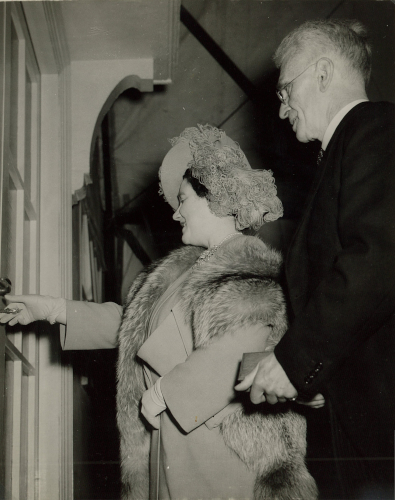
Opening of the temporary Library by Queen Elizabeth, 1946
In 1949, Queen Elizabeth was elected as Treasurer of the Middle Temple. In the same year her husband, King George VI, who had been elected to the Bench of Inner Temple in November 1917, was made Treasurer of that Inn. On Her Majesty’s election to the Bench in 1944, the Society had been prevented from receiving her in the Hall or with any great ceremony due to the privations of the time. In February 1944, the Queen’s private secretary wrote to the Treasurer that ‘The Queen shares your regret that the hazards of the past and the uncertainties of the present preclude the ceremonies which might, in more tranquil days, have marked Her Majesty’s association with your Honourable Society’ and ‘The Queen trusts that the day may not be far distant when she may be able once more to visit your famed Hall, restored to its former dignity and beauty’. The joint Treasurership of the monarchs provided the Middle Temple with the opportunity to host the type of event that they had been long denied and a great Joint Bench Dinner, presided over by the two Royal Treasurers, was held in Middle Temple Hall on 20 July 1949. The location was chosen both to celebrate the re-opening of the Hall after the completion of restoration works and out of necessity as Inner Temple Hall had been razed to the ground. To commemorate the event, the King and Queen both gave a gift to their respective Inns of a silver-gilt snuff box with their monogram set in diamonds.

Painting of the Joint Bench Dinner by Terence Cuneo, 1949
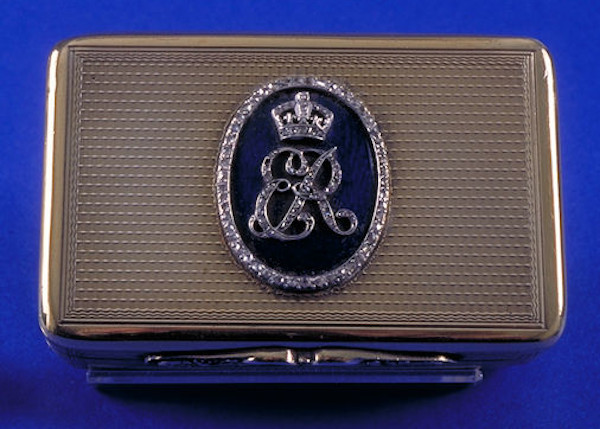
Silver-gilt snuff box given by Queen Elizabeth to the Middle Temple at the Joint Bench Dinner, 20 July 1949
Queen Elizabeth was a reliable presence at Grand Days and Family Dinners for fifty-seven years. Family Dinners, held in December, were conducted privately with Benchers in the Parliament Chamber, and the intimacy of the dinners made them a favourite of Her Majesty. On the occasion of her 90th birthday in 1990, the Benchers offered to make the dinner more of a ‘special occasion’ than usual, but her private secretary replied that ‘After much thought, the Queen Mother feels she would really prefer it if the usual much favoured drill could be followed, making the evening a delightfully intimate occasion’. The Family Dinners would sometimes be moved to the Hall and opened up to other members and students for special occasions, particularly for anniversaries of the Queen Mother’s Call to the Bench. Her Majesty attended Family Dinners every year, with very few exceptions, and often stayed much later than her programme demanded, delighting and testing the stamina of the attending Benchers. The last event that she attended at the Middle Temple at the age of one hundred and one was a Family Dinner held in December 2001.
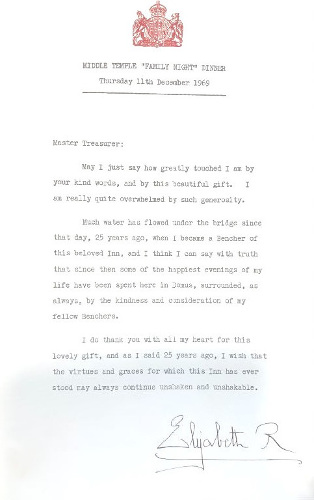
Letter of thanks sent by Queen Elizabeth, The Queen Mother for a gift presented at a Family Dinner marking the 25th Anniversary of her Call to the Bench, 11 December 1969 (MT/7/ROY/7/42)
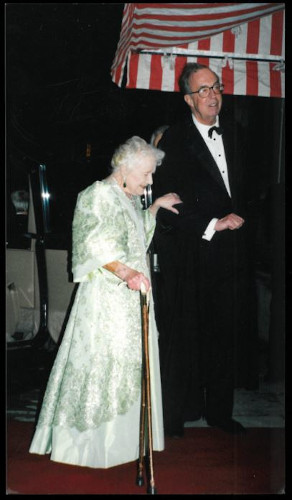
The Queen Mother at her last Family Dinner, December 2001 (MT/7/ROY/7/51)
The affection that the Inn held for its Royal Bencher led it to acquire several images of her during her lifetime and to incorporate her arms into the ceiling of the Queen’s Room when it was rebuilt in 1948 and renamed in honour of Her Majesty. A portrait of Queen Elizabeth was commissioned from the artist James Gunn by the Society in 1946 to celebrate their Royal Bencher, which currently hangs in the Queen’s Room. In 1981, owing to the relatively secluded location of the portrait, Master King-Hamilton commissioned a new portrait of the Queen Mother from the artist Peter Walbourn to hang on the library staircase where it could be viewed by every member of the Inn. The Queen Mother agreed to sit for the portrait on the condition that she could approve the artist and that she would not be painted in evening dress. Walbourn’s depiction is very different from Gunn’s and shows her standing in Middle Temple Garden wearing blue day-dress, a favourite colour of hers that set off her famous vivid blue eyes. The final image of the Queen Mother commissioned by the Inn was a bronze bust by the sculptor David Cregeen, in celebration of her 90th birthday in 1990. Two copies were made – one for the Middle Temple and one for the Queen Mother.
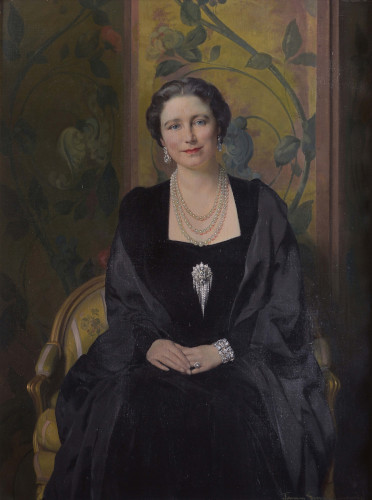
Portrait of Queen Elizabeth by James Gunn, 1946

Portrait of Queen Elizabeth, The Queen Mother by Peter Walbourn, 1981
Queen Elizabeth, The Queen Mother died on 30 March 2002, a little over three months after she attended her final Family Dinner at the Middle Temple. The Head Porter, Richard Sherrington, delivered flowers from the Society to St. James’ Palace and a Book of Condolence was signed by many members of the Inn. The comments written within the book reflect the great pleasure and privilege felt by everyone who knew her and stand as testament to the impact that she had at the Middle Temple.